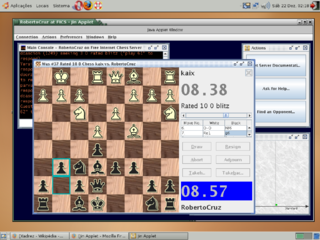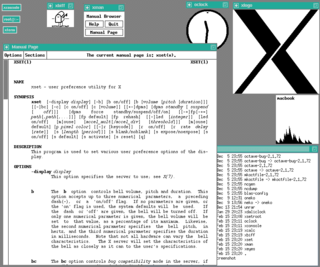An editor has nominated this article for deletion. You are welcome to participate in the deletion discussion , which will decide whether or not to retain it. |
The First Internet Backgammon Server (FIBS) began operating on July 19, 1992, allowing users to play backgammon in real-time against other people. [1] [2] It was hosted on the Internet, and could track player performance using a modified version of the Elo rating system. [3]
It was created by Andreas "Marvin" Schneider in 1992. [4] It has been maintained since 1996 by Patti Beadles. Anyone with access to the Internet can create a username and play for free. FIBS caters to a strong international community of backgammon players. [5] It was an immediate success, and no other backgammon server came online until 1997.
Early users connected to FIBS via a command line interface through TELNET similar to a MUD, with the standard backgammon board drawn in ASCII text. Dice rolls are represented numerically and moves are performed by entering starting and ending point numbers, similar to standard backgammon notation. Other game related commands are available by typing the appropriate command. The first graphical user interfaces for FIBS were developed in 1994; FIBS/W for Windows and MacFIBS for the classic Mac OS. Graphical interfaces continue to be developed for most major computing platforms, including mobile phones and tablets, however telnet remains the underlying protocol for FIBS. This allows anyone with access to the Internet to log into FIBS regardless of platform. [5]
Bots have been developed, some based on neural net programs like gnubg, JellyFish, TD-Gammon, and Snowie, to allow human players to compete with these computer programs on FIBS and to analyze these programs' performance in real-world play. [5] This is one way FIBS has served as an experimental platform for the advancement of computer science and continues to do so.
The server provided the first opportunity for backgammon players to be rated on the Elo rating system first devised for chess. The server has been used for testing artificial intelligence concepts using the backgammon bot LGammon, written by Mark Land of the University of California, San Diego. [6]
FIBS supports communication between players via text messages using the "shout" command which broadcasts to all players, in-game using the "kibitz" or "whisper" commands, and privately using the "tell" command. The "shout" command was initially implemented as a way for a player to find an opponent but has developed into a method of communicating with the general FIBS population. Users have a range of options to filter the amount of text messaging they receive, from ignoring troublesome users (with the "gag" command) to fully blocking receipt of all "shout" messages (using the "toggle silent" command). FIBS has a thriving program of tournaments and leagues, run by Tourneybot, which is supplied and maintained by Tom Moulton.

A bulletin board system (BBS), also called a computer bulletin board service (CBBS), is a computer server running software that allows users to connect to the system using a terminal program. Once logged in, the user performs functions such as uploading and downloading software and data, reading news and bulletins, and exchanging messages with other users through public message boards and sometimes via direct chatting. In the early 1980s, message networks such as FidoNet were developed to provide services such as NetMail, which is similar to internet-based email.
A multi-user dungeon, also known as a multi-user dimension or multi-user domain, is a multiplayer real-time virtual world, usually text-based or storyboarded. MUDs combine elements of role-playing games, hack and slash, player versus player, interactive fiction, and online chat. Players can read or view descriptions of rooms, objects, other players, and non-player characters, and perform actions in the virtual world that are typically also described. Players typically interact with each other and the world by typing commands that resemble a natural language, as well as using a character typically called an avatar.
Telnet is a client/server application protocol that provides access to virtual terminals of remote systems on local area networks or the Internet. It is a protocol for bidirectional 8-bit communications. Its main goal was to connect terminal devices and terminal-oriented processes.
The File Transfer Protocol (FTP) is a standard communication protocol used for the transfer of computer files from a server to a client on a computer network. FTP is built on a client–server model architecture using separate control and data connections between the client and the server. FTP users may authenticate themselves with a plain-text sign-in protocol, normally in the form of a username and password, but can connect anonymously if the server is configured to allow it. For secure transmission that protects the username and password, and encrypts the content, FTP is often secured with SSL/TLS (FTPS) or replaced with SSH File Transfer Protocol (SFTP).

A terminal emulator, or terminal application, is a computer program that emulates a video terminal within some other display architecture. Though typically synonymous with a shell or text terminal, the term terminal covers all remote terminals, including graphical interfaces. A terminal emulator inside a graphical user interface is often called a terminal window.

The Internet Chess Club (ICC) is a commercial Internet chess server devoted to the play and discussion of chess and chess variants. ICC had over 30,000 subscribing members in 2005. It was the first Internet chess server and was the largest pay to play chess server in 2005.
A talker is a chat system that people use to talk to each other over the Internet. Dating back to the 1980s, they were a predecessor of instant messaging. A talker is a communication system precursor to MMORPGs and other virtual worlds such as Second Life. Talkers are a form of online virtual worlds in which multiple users are connected at the same time to chat in real-time. People log in to the talkers remotely, and have a basic text interface with which to communicate with each other.

XBoard is a graphical user interface chessboard for chess engines under the X Window System. It is developed and maintained as free software by the GNU project. WinBoard is a port of XBoard to run natively on Microsoft Windows.

The Free Internet Chess Server (FICS) is a volunteer-run Internet chess server. It was organised as a free alternative to the Internet Chess Club (ICC), after that site began charging for membership.

In computer chess, a chess engine is a computer program that analyzes chess or chess variant positions, and generates a move or list of moves that it regards as strongest.
Synchronet is a multiplatform BBS software package, with current ports for Microsoft Windows, Linux, and BSD variants. Past versions also ran on MS-DOS and OS/2, but support for those platforms were dropped in version 3.0.
The Sierra Network (TSN), later rebranded as the ImagiNation Network (INN), was an online service launched in 1991 by Sierra On-Line. First developed in 1989 and launched to the public in 1991, it offered subscribers a unique online space to play games and socialize, billing itself as a "cyberspace theme park." This service was the first exclusively focused on online gaming and was among the early adopters of online avatars, laying the groundwork for future gaming communities.
An Internet bot, web robot, robot or simply bot, is a software application that runs automated tasks (scripts) on the Internet, usually with the intent to imitate human activity, such as messaging, on a large scale. An Internet bot plays the client role in a client–server model whereas the server role is usually played by web servers. Internet bots are able to perform simple and repetitive tasks much faster than a person could ever do. The most extensive use of bots is for web crawling, in which an automated script fetches, analyzes and files information from web servers. More than half of all web traffic is generated by bots.
An Internet chess server (ICS) is an external server that provides the facility to play, discuss, and view the board game of chess over the Internet. The term specifically refers to facilities for connecting players through a variety of graphical chess clients located on each user's computer.

In computing, a shell is a computer program that exposes an operating system's services to a human user or other programs. In general, operating system shells use either a command-line interface (CLI) or graphical user interface (GUI), depending on a computer's role and particular operation. It is named a shell because it is the outermost layer around the operating system.
Amiga software is computer software engineered to run on the Amiga personal computer. Amiga software covers many applications, including productivity, digital art, games, commercial, freeware and hobbyist products. The market was active in the late 1980s and early 1990s but then dwindled. Most Amiga products were originally created directly for the Amiga computer, and were not ported from other platforms.

Minnesota Internet Users Essential Tool (Minuet) is an integrated Internet package for DOS operating systems on IBM-compatible PCs.
A home server is a computing server located in a private computing residence providing services to other devices inside or outside the household through a home network or the Internet. Such services may include file and printer serving, media center serving, home automation control, web serving, web caching, file sharing and synchronization, video surveillance and digital video recorder, calendar and contact sharing and synchronization, account authentication, and backup services. In the recent times, it has become very common to run hundreds of applications as containers, isolated from the host operating system.
Online games are video games played over a computer network. The evolution of these games parallels the evolution of computers and computer networking, with new technologies improving the essential functionality needed for playing video games on a remote server. Many video games have an online component, allowing players to play against or cooperatively with players across a network around the world.